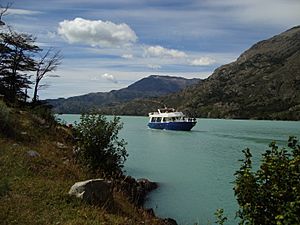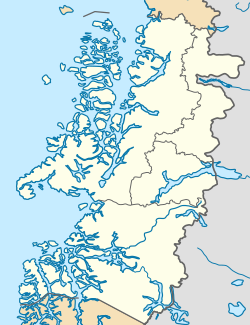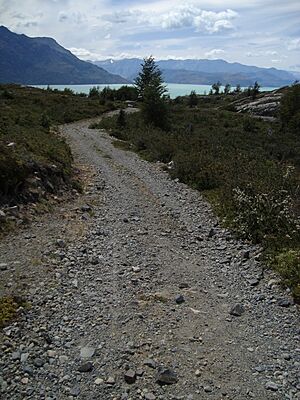Candelario Mancilla facts for kids
Quick facts for kids
Candelario Mancilla
|
||
|---|---|---|

Ferry at Candelario Mancilla
|
||
|
|
||
| Country | Chile | |
| Region | Aysen | |
| Province | Capitán Prat | |
| Commune | O'Higgins | |
| Population | ||
| • Total | 2 | |
| Climate | Cfb | |
Candelario Mancilla is a tiny settlement in the Aysén Region of southern Chile. It sits right on the shores of Lake O'Higgins/San Martín.
This small place is about 16 kilometers (10 miles) north of the border with Argentina. It's a really important stop for tourists traveling between Villa O'Higgins in Chile and El Chaltén in Argentina.
To reach Candelario Mancilla from other parts of Chile, you need to take a ferry. This ferry connects the settlement to Villa O'Higgins, which is where the famous Carretera Austral (Southern Highway) ends.
Only a few people live here: one family of Chilean settlers and some Carabineros (Chilean police) who work as border guards. The settlement is named after José Candelario Mancilla Uribe, a pioneer who settled by Lake O'Higgins in 1927.
In the past, many climbers and scientists visited this area. They explored the region or traveled towards the huge glaciers on the lake. In November 2001, a border crossing called "Dos Lagunas" opened between Chile and Argentina. This has made the area much more popular for tourists. Today, about 2,000 visitors pass through Candelario Mancilla each year.
The area is close to Del Desierto Lake. Chile and Argentina had a disagreement over this lake's border until 1994. In 1965, an event happened where a Chilean Carabinero, Hernán Merino Correa, died. This occurred during a clash with the Argentine Gendarmerie.
Near the border, you can find the Laguna Redonda Airport. You can get there from route X-915. From Candelario Mancilla, you can also see Cerro Tobi mountain. The pier (dock) at the settlement is called "Sofanor Mancilla".
History of Candelario Mancilla
José Candelario Mancilla Uribe (1900-1967) was a Chilean pioneer who lived by Lake O'Higgins. He arrived in the area in 1927 with his wife, Teresa Mancilla Oyarzún (1906-1992). They had moved from Puerto Montt to Punta Arenas. After getting married in 1921, they worked on farms in the Argentine province of Santa Cruz. Finally, they reached Lake O'Higgins/San Martín in 1927. The couple had six children, most of whom were born at Lake O'Higgins.
The area where Candelario Mancilla is located was first settled by British immigrants. Since 1933, the Mancilla family has lived there. They worked very hard to establish their home, just like dozens of other families spread around Lake O'Higgins.
José Candelario Mancilla and other settlers often asked the government for help. However, they usually received no support. They had to rely on their own efforts to survive and build their lives.
One important event was the building of a landing strip in the Ventisquero Chico area in 1956. This allowed planes from the Chilean Air Force to land there. It was the first time the government provided direct support to the pioneers of the lake.
In 1961, a group of Carabineros de Chile set up a small station on land given by Mancilla. Years later, there were serious border events between the Chilean and Argentine police forces. These were about who owned the Laguna del Desierto area. Mancilla actively supported the Chilean units, which earned him recognition from the president at that time.
It was the Mancilla family themselves who gave the place its name. This name was officially recognized when the wharf was built in 1992. Since then, travel guides and tourism have made the name well-known. It is now a must-see spot for travelers and adventurers from all over the world.
Candelario Mancilla Today
Today, the only settlers living in Candelario Mancilla are the family members who are descendants of Candelario Mancilla. They live on their ranch and tourist farm called "Santa Teresita." Also present are the police officers of the Carabineros de Chile station, named "Hernán Merino Correa."
In 2012, the local government of Aysén planned to expand the settlement of Candelario Mancilla. They wanted to include it in a special policy for isolated areas.
Images for kids
See also
 In Spanish: Candelario Mancilla para niños
In Spanish: Candelario Mancilla para niños




